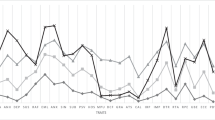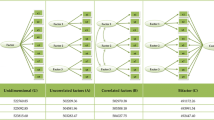Abstract
While psychopathology emerges during late childhood and becomes more evident during adolescence, limited research has examined the associations between personality types and the risk of clinical-level adaptation problems in preadolescents. This study identified personality types based on the five-factor model and evaluated the risk of clinical-level behavioral problems according to personality type. Participants consisted of 1,332 preadolescents (mean age = 11.356 years) from the Panel Study on Korean Children. Latent profile analyses were conducted to identify the personality types of preadolescents. The links between the personality types and the risk of clinical-level behavior problems were tested with multinominal logistic regressions. The participants were classified into four personality types: ordinary (42.3%), resilient (17.0%), undercontrollers (32.3%), and overcontrollers (8.5%). The overcontrollers had a greater risk of clinical-level total behavior problems when compared to the ordinary type. The undercontrollers demonstrated a greater risk of clinical-level external behavior problems as compared to the ordinary type. These findings highlight the potential usefulness of personality typology as a practical transdiagnostic tool for identifying preadolescents who may be at risk of experiencing clinical-level adaptation problems associated with specific personality types.
Similar content being viewed by others
Data Availability
This study utilized publicly released data, which is freely available for download at the following link: [https://panel.kicce.re.kr/pskc/module/rawDataManage/index.do?menu_idx=56].
References
Achenbach, T. M., & Rescorla, L. A. (2001). Manual for the ASEBA School-Age Forms & Profiles. University of Vermont, Research Center for Children, Youth, & Families.
Ahn, H. N., & Ahn, C. K. (2017). Neo Personality Assessment System. Insight.
Alessandri, G., & Vecchione, M. (2017). Resilient, undercontrolled, and overcontrolled personality types across cultures. In A. T. Church (Ed.), The Praeger handbook of personality across cultures: Culture and characteristic adaptations (pp. 211–246). Praeger/ABC-CLIO.
Allen, T. A., & Hallquist, M. N. (2020). Disinhibition and detachment in adolescence: a developmental cognitive neuroscience perspective on the alternative model for personality disorders. Psychopathology, 53(3–4), 205–212. https://doi.org/10.1159/000509984
Asendorpf, J. B. (2015). Person-centered approaches to personality. In M. Mikulincer, P. R. Shaver, M. L. Cooper, & R. J. Larsen (Eds.), APA Handbook of Personality and Social Psychology, Vol. 4. Personality Processes and Individual Differences (pp. 403–424). American Psychological Association. https://doi.org/10.1037/14343-018
Baams, L., Overbeek, G., Dubas, J. S., & Van Aken, M. A. (2014). On early starters and late bloomers: The development of sexual behavior in adolescence across personality types. The Journal of Sex Research, 51(7), 754–764. https://doi.org/10.1080/00224499.2013.802758
Berardelli, I., Serafini, G., Cortese, N., Fiaschè, F., O’Connor, R. C., & Pompili, M. (2020). The involvement of hypothalamus–pituitary–adrenal (HPA) axis in suicide risk. Brain Sciences, 10(9), 653. https://doi.org/10.3390/brainsci10090653
Birkeland, S., Linkhorst, T., Haakonsson, A., Barry, M. J., & Möller, S. (2020). Representativeness of personality and involvement preferences in a web-based survey on healthcare decision-making. BMC Health Services Research, 20(1), 1–8. https://doi.org/10.1186/s12913-020-05717-1
Boehm, B., Asendorpf, J. B., & Avia, M. D. (2002). Replicable types and subtypes of personality: Spanish NEO-PI samples. European Journal of Personality, 16(1_suppl), S25–S41. https://doi.org/10.1002/per.450
Chanen, A. M., & Thompson, K. N. (2019). The age of onset of personality disorders. In de G. Girolamo, P. McGorry, & N. Sartorius (Eds.), Age of onset of mental disorders. Springer. https://doi.org/10.1007/978-3-319-72619-9_10
Chen, W., Xie, X. C., Ping, F., & Wang, M. Z. (2017). Personality differences in online and offline self-disclosure preference among adolescents: A person-oriented approach. Personality and Individual Differences, 105, 175–178. https://doi.org/10.1016/j.paid.2016.09.048
De Caluwé, E., Decuyper, M., & De Clercq, B. (2013). The child behavior checklist dysregulation profile predicts adolescent DSM-5 pathological personality traits 4 years later. European Child & Adolescent Psychiatry, 22, 401–411. https://doi.org/10.1111/j.1469-7610.2011.02512.x
De Clercq, B., Rettew, D., Althoff, R. R., & De Bolle, M. (2012). Childhood personality types: Vulnerability and adaptation over time. Journal of Child Psychology and Psychiatry, 53(6), 716–722. https://doi.org/10.1111/j.1469-7610.2011.02512.x
Donnellan, M. B., & Robins, R. W. (2010). Resilient, overcontrolled, and undercontrolled personality types: Issues and controversies. Social and Personality Psychology Compass, 4(11), 1070–1083. https://doi.org/10.1111/j.1751-9004.2010.00313.x
Favini, A., Gerbino, M., Eisenberg, N., Lunetti, C., & Thartori, E. (2018). Personality profiles and adolescents’ maladjustment: A longitudinal study. Personality and Individual Differences, 129, 119–125. https://doi.org/10.1016/j.paid.2018.03.016
Ferguson, S. L., Moore, G., E. W., & Hull, D. M. (2020). Finding latent groups in observed data: A primer on latent profile analysis in Mplus for applied researchers. International Journal of Behavioral Development, 44(5), 458–468. https://doi.org/10.1177/0165025419881721
Haslam, N. (2016). Bell-shaped distribution of personality traits. In V. Zeigler-Hill, & T. Shackelford (Eds.), Encyclopedia of personality and individual differences. Springer. https://doi.org/10.1007/978-3-319-28099-8_1047-1
Kamper, S. J. (2020). Sampling: Linking evidence to practice. Journal of Orthopaedic & Sports Physical Therapy, 50(12), 725–726. https://doi.org/10.2519/jospt.2020.0704. https://www.jospt.org/doi/
Klimstra, T. A., Hale, I. I. I., Raaijmakers, W. W., Branje, Q. A., S. J., & Meeus, W. H. (2010). A developmental typology of adolescent personality. European Journal of Personality, 24(4), 309–323. https://doi.org/10.1002/per.744
Kotov, R., Gamez, W., Schmidt, F., & Watson, D. (2010). Linking big personality traits to anxiety, depressive, and substance use disorders: A meta-analysis. Psychological Bulletin, 136(5), 768–821. https://doi.org/10.1037/a0020327
Malouff, J. M., Thorsteinsson, E. B., & Schutte, N. S. (2005). The relationship between the five-factor model of personality and symptoms of clinical disorders: A meta-analysis. Journal of Psychopathology and Behavioral Assessment, 27, 101–114. https://doi.org/10.1007/s10862-005-5384-y
Mascia, M. L., Langiu, G., Bonfiglio, N. S., Penna, M. P., & Cataudella, S. (2023). Challenges of preadolescence in the school context: A systematic review of protective/risk factors and intervention programmes. Education Sciences, 13(2), 130. https://doi.org/10.3390/educsci13020130
McCrae, R. R., & Costa, P. T. (2003). Personality in adulthood: A five-factor theory perspective. Guilford Press.
Meeus, W., Van de Schoot, R., Klimstra, T., & Branje, S. (2011). Personality types in adolescence: Change and stability and links with adjustment and relationships: A five-wave longitudinal study. Developmental Psychology, 47(4), 1181. https://doi.org/10.1037/a0023816
Oh, K., Kim, Y., Ha, E., Lee, H., & Hong, K. (2010). Korean Version of Child Behavior Checklist for Ages 6–18. Huno.
Paulus, D. J., Talkovsky, A. M., Heggeness, L. F., & Norton, P. J. (2015). Beyond negative affectivity: A hierarchical model of global and transdiagnostic vulnerabilities for emotional disorders. Cognitive Behaviour Therapy, 44(5), 389–405. https://doi.org/10.1080/16506073.2015.1017529
Rolland, J. P. (2002). The cross-cultural generalizability of the five-Factor model of personality. In R. R. McCrae & J. Allik (Eds.), The Five-Factor Model of Personality Across Cultures (pp. 7–28). Kluwer Academic/Plenum Publishers. https://doi.org/10.1007/978-1-4615-0763-5_2
Schulze, L., Schulze, A., Renneberg, B., Schmahl, C., & Niedtfeld, I. (2019). Neural correlates of affective disturbances: A comparative meta-analysis of negative affect processing in borderline personality disorder, major depressive disorder, and posttraumatic stress disorder. Biological Psychiatry: Cognitive Neuroscience and Neuroimaging, 4(3), 220–232. https://doi.org/10.1016/j.bpsc.2018.11.004
Serafini, G., Adavastro, G., Canepa, G., Capobianco, L., Conigliaro, C., Pittaluga, F., & Amore, M. (2017). Abnormalities in kynurenine pathway metabolism in treatment-resistant depression and suicidality: A systematic review. CNS & neurological Disorders-Drug targets. & Neurological Disorders), 16(4), 440–453. https://doi.org/10.2174/1871527316666170413110605. (Formerly Current Drug Targets-CNS.
Thalmayer, A. G., & Rossier, J. (2019). Agreeableness, antagonism, and mental health across cultures. In J. W. Miller, & D. Lynam (Eds.), The handbook of antagonism (pp. 97–111). Academic Press.
Thomas, K. M., Yalch, M. M., Krueger, R. F., Wright, A. G., Markon, K. E., & Hopwood, C. J. (2013). The convergent structure of DSM-5 personality trait facets and five-factor model trait domains. Assessment, 20(3), 308–311. https://doi.org/10.1177/1073191112457589
van Dijk, I., Krueger, R. F., & Laceulle, O. M. (2021). DSM–5 alternative personality disorder model traits as extreme variants of five-factor model traits in adolescents. Personality Disorders: Theory Research and Treatment, 12(1), 59–69. https://doi.org/10.1037/per0000409
Vize, C. E., Ringwald, W. R., Edershile, E. A., & Wright, A. G. (2022). Antagonism in daily life: An exploratory ecological momentary assessment study. Clinical Psychological Science, 10(1), 90–108. https://doi.org/10.1177/21677026211013507
Watson, D., Stasik, S. M., Ro, E., & Clark, L. A. (2013). Integrating normal and pathological personality: Relating the DSM-5 trait-dimensional model to general traits of personality. Assessment, 20(3), 312–326. https://doi.org/10.1177/1073191113485810
Widiger, T. A., & Oltmanns, J. R. (2017). Neuroticism is a fundamental domain of personality with enormous public health implications. World Psychiatry, 16(2), 144. https://doi.org/10.1002/wps.20411
Wright, A. G., Thomas, K. M., Hopwood, C. J., Markon, K. E., Pincus, A. L., & Krueger, R. F. (2012). The hierarchical structure of DSM-5 pathological personality traits. Journal of Abnormal Psychology, 121(4), 951. https://doi.org/10.1037/a0027669
Yin, K., Lee, P., Sheldon, O. J., Li, C., & Zhao, J. (2021). Personality profiles based on the FFM: A systematic review with a person-centered approach. Personality and Individual Differences, 180, 110996. https://doi.org/10.1016/j.paid.2021.110996
Funding
The authors declare that no funding source is associated with this study.
Author information
Authors and Affiliations
Corresponding author
Ethics declarations
Conflict of interest
There are no conflicts of interest involved with this research.
Ethics approval Statement
All procedures performed in studies involving human participants were in accordance with the ethical standards of the institutional and/or national research committee and with the 1964 Helsinki declaration and its later amendments or comparable ethical standards.
Informed consent
Informed consent was obtained from all individual participants included in the study.
Additional information
Publisher’s Note
Springer Nature remains neutral with regard to jurisdictional claims in published maps and institutional affiliations.
Rights and permissions
Springer Nature or its licensor (e.g. a society or other partner) holds exclusive rights to this article under a publishing agreement with the author(s) or other rightsholder(s); author self-archiving of the accepted manuscript version of this article is solely governed by the terms of such publishing agreement and applicable law.
About this article
Cite this article
Kim, Y.H. Personality types and the risk of clinical-level adaptation problems of Korean preadolescents: A population-based study. Curr Psychol 43, 10894–10903 (2024). https://doi.org/10.1007/s12144-023-05226-4
Accepted:
Published:
Issue Date:
DOI: https://doi.org/10.1007/s12144-023-05226-4




